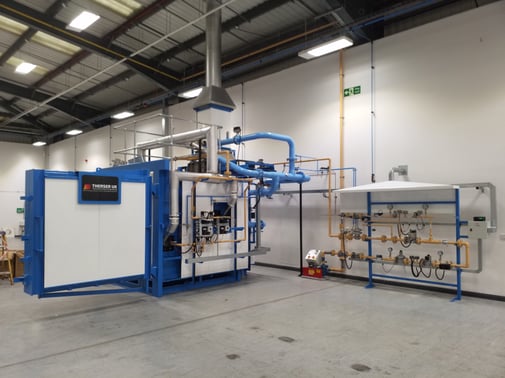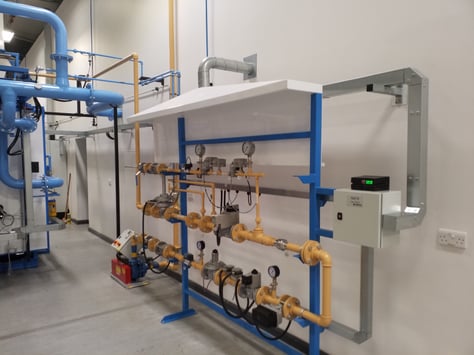Share this
Hydrogen as a Fuel for Kilns: Revolutionizing the Heat Treatment Industry with Green Energy
by Therser UK on 06-Feb-2024 10:07:46
In the quest for sustainable and eco-friendly manufacturing practices, industries worldwide are exploring alternative energy sources that can reduce carbon emissions and mitigate climate change. One such pioneering shift is happening in the heat treatment industry, with companies like Therser UK leading the charge towards hydrogen as the next-generation fuel for powering kilns. This move is not just about adhering to environmental regulations; it's about setting a new standard for the industry, demonstrating that green energy can be both viable and beneficial for high-temperature processes like firing ceramics.
The Shift Towards Hydrogen
Hydrogen is emerging as a compelling alternative to traditional fossil fuels due to its clean combustion properties. When burned, hydrogen produces water vapor as its primary byproduct, eliminating the carbon dioxide emissions associated with coal, natural gas, and other hydrocarbon fuels. This characteristic makes hydrogen an attractive option for industries looking to decarbonize their operations.
Therser UK: A Pioneer in Hydrogen-Fueled Kilns
Therser UK, the UK's leading manufacturer of high-temperature kilns and furnaces, is at the forefront of adopting hydrogen fuel technology. Recognizing the environmental and economic benefits of hydrogen, Therser UK has embarked on integrating hydrogen-fueled kilns into their offerings, showcasing a commitment to innovation and sustainability.

The Environmental Impact
The adoption of hydrogen as a fuel for kilns represents a significant stride towards reducing industrial carbon footprints. Scientific data underscores the urgency of this transition. According to the International Energy Agency (IEA), the global ceramics industry is a notable energy consumer, utilizing significant quantities of fossil fuels, which contributes to greenhouse gas emissions. By switching to hydrogen, companies like Therser UK can help drastically cut these emissions.
Economic and Operational Advantages
Beyond its environmental credentials, hydrogen offers several economic and operational benefits. Hydrogen can be produced locally, reducing dependency on fossil fuel imports and enhancing energy security. Additionally, hydrogen-fired kilns can achieve high temperatures more efficiently than their traditional counterparts, potentially lowering energy costs and improving production efficiency.

Challenges and Future Prospects
Despite its advantages, the transition to hydrogen fuel in the ceramics industry faces challenges. These include the initial costs of developing and installing hydrogen-compatible kiln technology, the need for a reliable supply of green hydrogen, and ensuring safety in handling and storage. However, ongoing advancements in hydrogen production, such as the scaling up of electrolysis and the development of green hydrogen projects, are making this fuel more accessible and affordable.
As we look to the future, our pioneering work in hydrogen-fueled kilns stands as a beacon for the ceramics industry and beyond. The commitment to sustainability and innovation not only enhances our green credentials but also paves the way for widespread adoption of hydrogen as a clean, efficient fuel for industrial processes. The transition to hydrogen reflects a broader movement towards sustainable manufacturing, aligning with global efforts to combat climate change and foster a greener economy.
Hydrogen is more than just an alternative fuel; it's a key to unlocking a sustainable future for the ceramics industry and manufacturing at large. We are not just adapting to change; we are driving it, demonstrating that environmental responsibility and economic prosperity can go hand in hand. As the industry continues to evolve, hydrogen-fueled kilns may soon become the standard, marking a new era of green manufacturing.
For al enquires call 01782 824453
email sales@therseruk.com
Share this
- Company News (90)
- Battery Materials (41)
- kiln (37)
- fabrication (29)
- Alloy (27)
- Furnace (27)
- Welding (16)
- Industrial Kilns (15)
- Battery (13)
- Ceramic Kilns (13)
- Processes (13)
- alloy fabrication (13)
- Shuttle Kilns (12)
- RTO’s (11)
- Vacancies (11)
- Hydrogen (10)
- Therser UK (9)
- Tunnel Kiln (9)
- Refractory (8)
- Therser (8)
- Wellman Furnaces (8)
- Brickwork (7)
- Case Studies (7)
- Afterburners (6)
- Fibre Lining (6)
- electric (6)
- Almor Wellman (5)
- thermal engineers (5)
- Biochar (4)
- Exhibition (4)
- Pyrolysis (4)
- Servicing (4)
- Spares (4)
- heat treatment (4)
- History (3)
- Ceramics Uk (2)
- Combustion Control Upgrades (2)
- Nitrogen (2)
- Temperature Control Rings (2)
- gas (2)
- Certificates (1)
- Instrumentation (1)
- MMC (1)
- RHK (1)
- Roller Hearth Kiln (1)
- Test Trials (1)
- aerospace (1)
- analyser (1)
- elec (1)
- oxygen (1)
- vans (1)
- September 2025 (2)
- May 2025 (2)
- March 2025 (1)
- February 2025 (2)
- January 2025 (5)
- December 2024 (5)
- November 2024 (7)
- October 2024 (5)
- September 2024 (4)
- August 2024 (14)
- July 2024 (13)
- June 2024 (2)
- May 2024 (5)
- April 2024 (13)
- March 2024 (8)
- February 2024 (12)
- January 2024 (14)
- December 2023 (6)
- November 2023 (12)
- October 2023 (24)
- September 2023 (11)
- August 2023 (11)
- July 2023 (9)
- June 2023 (15)
- May 2023 (53)
- April 2023 (5)
- March 2023 (6)
- February 2023 (7)
- January 2023 (3)
- December 2022 (8)
- November 2022 (5)
- October 2022 (11)
- September 2022 (1)
- August 2022 (2)
- July 2022 (1)
- June 2022 (2)
- May 2022 (1)
- March 2022 (1)
- February 2022 (1)
- January 2022 (1)
- December 2021 (3)
- October 2021 (1)
- August 2021 (1)
- June 2021 (1)
- May 2021 (4)
- April 2021 (2)
- March 2021 (4)
- February 2021 (2)
- December 2020 (3)
- November 2020 (1)
- September 2020 (3)
- May 2020 (1)
- April 2020 (2)
- March 2020 (1)
- January 2020 (1)
- December 2019 (1)
- July 2019 (2)
- June 2019 (1)
- April 2019 (2)
- March 2019 (3)
- February 2019 (4)
- December 2018 (1)
- November 2018 (1)
- September 2018 (2)
- August 2018 (1)
- July 2018 (1)
- May 2018 (3)
- April 2018 (1)
- February 2018 (3)
- January 2018 (2)
- December 2017 (3)
- November 2017 (1)
- October 2017 (2)
- September 2017 (4)
- August 2017 (1)
- July 2017 (2)
- June 2017 (2)
- May 2017 (3)
- April 2017 (3)

